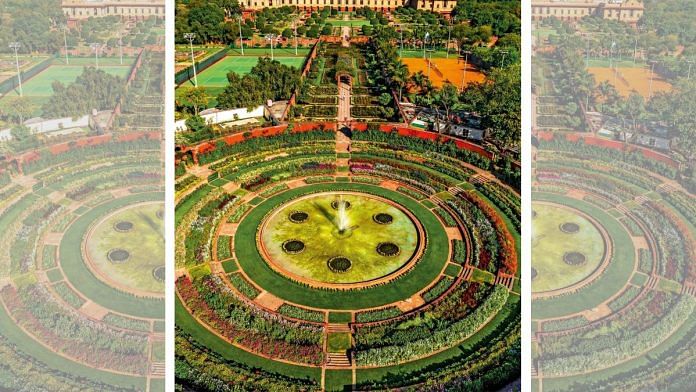New Delhi: As the sprawling lawns and flower beds within the perfectly symmetrical Rashtrapati Bhavan garden, popularly called the Mughal Garden, was rechristened as Amrit Udyan last month, Delhi-based Karwaan: The Heritage Exploration Initiative decided it was time for a history lesson – albeit not through a seminar or lecture but a heritage walk.
Titled ‘The Idea of Mughal Garden’, the heritage walk through Sunder Nursery explores the concept of a Mughal garden and the various examples of it in the city.
“The garden behind Rashtrapati Bhawan has nothing to do with the Mughals. It was a completely British creation. Why they named it the Mughal Gardens and why Mughals are generally associated with gardens, is what you will understand in this walk,” said Gaurav Sharma opening the walk. A guest faculty at NIFT Delhi, he is one of the many resource persons part of the initiative.
Designed by Edwin Lutyens in 1917, the erstwhile Mughal Garden blends elements of the Mughal style, reflected in the water canals and terraces, with English flower beds, lawns and hedges. The role of the Mughals was inspirational at best. The 15-acre garden was never officially named Mughal Gardens, it was called so due to the style of architecture.
Sharma has been conducting heritage walks about the various gardens built by the Mughals since 2016, but it was called “Idea of a Paradise Garden”. When the government changed the name of the Mughal Garden the tour was renamed to keep it relevant.
“The government gets to pick and choose things and try to deny their existence, that’s not the correct way of looking at your (Indian) past, that’s what we believe,” he said.
Also Read: Don’t feel hurt over Amrit Udyan. Pasmanda Muslims have no nostalgia for Mughals
How Mughals shaped the Indian psyche
Sharma said that only the name of the walk has changed, the content remains the same. “In the Indian landscape, gardens are associated with the Mughals. No one, at least I don’t recall any other king before the Mughals making gardens on this large a scale,” Sharma said to ThePrint.
“There were so many kings in Kashmir before the Mughals, but nobody converted that landscape into gardens, it’s the Mughals who did it. In Delhi, Agra and Burhanpur they have done beautiful gardening. Wherever they were going, they were building gardens. By the time the British entered India the garden could only be something that could be Mughal in the Indian psyche,” he summarised.
He claimed that the British replicated Mughal-style gardens because they feared that people would think of the city as “white”.
During the nearly two-and-half-hour walk through Sunder Nursery, Sharma gave an animated tour of how the Mughal gardens came to be.
He narrated how the Mughal emperor Babur built the first charbagh in India– a quadrilateral garden layout meant to resemble the garden of Eden (paradise) described in the Quran.
Akbar continued the tradition of his grandfather and the charbagh was built in different locations such as Delhi and Agra. But Akbar’s son, Jahangir, moved to Kashmir, where the terrain didn’t allow for the creation of a traditional charbagh.
“There he saw farmers doing step farming and made a stepped garden. For Kashmiris, the idea of the Mughal garden is different than for those in Delhi,” Sharma said, adding that in Kashmir a Mughal garden would have a cascading waterfall.
He also noted that buildings and landscapes are often geography-bound and not religion-bound.
Also Read: Mughal Gardens renamed ‘Amrit Udyan’ — BJP hails move, Congress calls it ‘narrow-mindedness’
Mughal vs British concept of garden
Sharma, who also leads another popular heritage walk on the ‘Tawaifs of Old Delhi’ noted that the gardens created by the Mughals were about “whatever suited the local geography and local climate”. This was in contrast to the British gardens which were “experimental”.
“Britishers wanted to make the city green,” he said, adding that they introduced invasive plants in the process because they planted saplings without giving too much thought.
“Grass was introduced by the British because they were missing their green gardens and lawns,” Sharma remarked.
Grass was “definitely not there” in the Mughal gardens, he said, explaining that the Mughals preferred large trees since the garden was created as an escape during the summer months.
Also Read: Move over Golconda, Charminar—Aga Khan Trust is bringing back to life a hidden Hyderabad necropolis
‘History should be seen objectively’
Sharma emphasised the importance of looking at history objectively to the 10 curious people who turned up for the walk.
“Any ruler, whether Mughals or any other, should be seen objectively. You may criticise them for their political decisions, for what they could have done given the resources they had, but it’s not the same for whatever they built or what people cherished or enjoyed. All of a sudden one day you cannot turn up and say this didn’t happen or deny its existence,” he said.
(Edited by Theres Sudeep)



